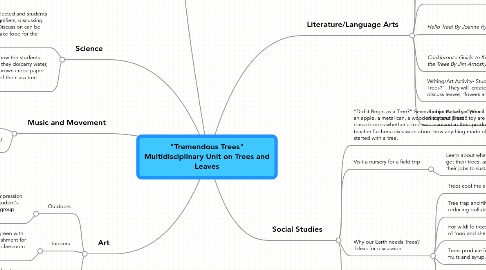
1. Math
1.1. Patterning
1.1.1. "Pattern Leaves" Leaf cutouts in variety of colors can be glued on sentence strips to establish pattern. Extra loose leaves are supplied to have student manipulate the leaves to continue each pattern. (AB, ABB, ABC, AABB, ABA)
1.2. Classifying
1.2.1. "Classifying Leaves" Students will collect different types of tree leaves from home. Once brought into class the class can be divided into groups with a variety of leaves to classify by color, shape, texture, size.
1.3. Graphing
1.3.1. "Graphing Leaves" The students will do graphing activity noting most common, least common leaf and their orgin (tree family)
2. Art
2.1. Outdoors
2.1.1. "Bark Designs" Students use color rub to make impression of bark, with white paper and brown color. The student's art is added to the classroom paper tree. Whole group activity to discuss attributes of bark.
2.2. Indoors
2.2.1. "Leaf patterns" can be painted green with green-tinted glue to add embellishment for veins. The art can be added to a classroom tree.
2.3. Indoors
2.3.1. "Tiny Trees" Craft Project. Students will create their own table top trees by sponge painting the canopy part of the tree. The bark can be created by placing the pattern of the trunk on top of a piece of crumpled paper before coloring with the side of an unwrapped crayon.
3. Science
3.1. Real leaves should be collected and students can observe through magnifiers, discussing vein pattern and colors. Discussion can be held about how leaves make food for the trees.
3.1.1. Student experiment with colored water, leaves and vein pattern.
3.2. Learning about the "roots" of a tree. Show the students what roots looks like and describe what they do(carry water, support the tree, etc) Children can use brown crepe paper and brown yarn to tape to the bottom of the class tree trunk.
4. Music and Movement
4.1. Action Chant: "I am a Tree": I am a tree, These are my roots, they help hold me up, like a strong pair of boots! (Lyrics and body motions continue)
4.2. "Let's tell about a tree" Sung to Farmer and the Dell.
5. Literature/Language Arts
5.1. The Tremendous Tree Book By May Garelick
5.2. Tree Trunk Traffic By Bianca Lavies
5.3. Red Leaf, Yellow Leaf By Lois Ehlert
5.4. Once There was a Tree By Laura Coats
5.5. Hello Tree! By Joanne Ryder
5.5.1. After reading this book, children are taken outside on the playground and asked to lie down on towels in a big circle under the tree, so that their feet are toward the trunk and they can clearly observe the tree's canopy. Each child says a word that describes something about the tree. Record their responses.
5.6. Crinkleroot's Guide to Knowing the Trees By Jim Arnosky
5.7. Writing/Art Activity- Students will make their own booklet "What Grows on Trees?" They will create pictures and have writing opportunities to discuss leaves, flowers and fruit.
5.8. Journal Activity: "What I like about Trees"
6. Social Studies
6.1. "Did it Begin as a Tree?" Several objects such as pencil, a book, a t-shirt, an apple, a metal can, a wooden toy and plastic toy are displayed. The class decides whether a tree was involved in their production. The teacher furthers discussion about how anything made of wood or paper all started with a tree.
6.1.1. Exploring a cross section from a log to enable students to make connection that wood is beneath the tree's bark.
6.2. Visit a nursery for a field trip
6.2.1. Learn about what a nursery is, where they get their trees, and what the workers do on their jobs to sustain the nursery
6.3. Why our Earth needs Trees? Ideas for discussion
6.3.1. Trees cool the air.
6.3.2. Tree trap and filter dust, reducing pollution.
6.3.3. For wildlife trees are a source of food and shelter.
6.3.4. Trees produce foods, such as fruits and syrup.
6.3.5. Tees make our world beautiful by camouflaging unsightly things, producing blooms and adding color.
6.3.6. Trees give off oxygen to help us live!
6.4. "Animals need trees!" Using the book Tree Trunk Traffic will set the stage for discussion about how a tree helps each animal and in some cases is their home.
6.4.1. Teacher draws a large tree and labels each part, "basement", "first floor" and "top floor" Students can name which animals might live on which floor of the tree hotel. e.g. worms and lizards live in the basement, raccoons, in the first floor, and squirrels the top.
